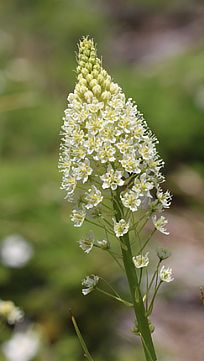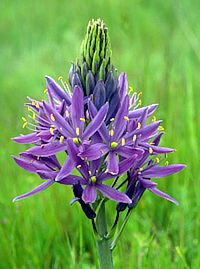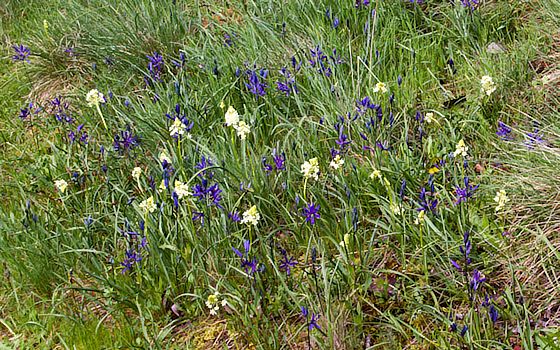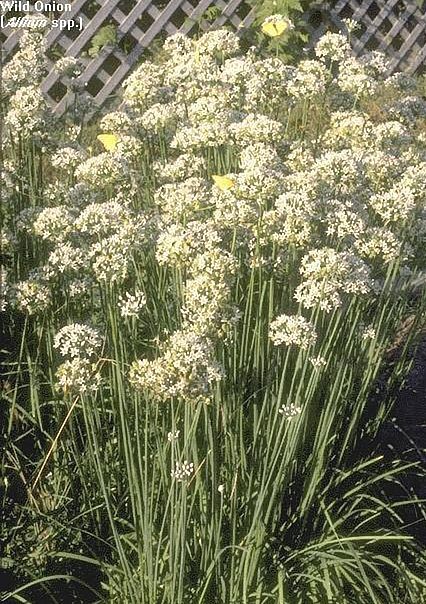The Camas lily was used by Native Americans for medicinal purposes and its root bulbs were collected to make bread, or roasted like a potato.

During their exploration of the area, Lewis and Clark — low on food at the time — were introduced to the plant by the Shoshone and Nez Perce tribes.
Given the importance of this plant species to the Nez Perce, Meriwether Lewis prepared a 1,500-word description of the plant and its uses.


In another description of this species written in June of 1806, Lewis mistook … a valley of blooming camas (lilies) as a lake, stating, “From the colour of its bloom at a short distance it resembles lakes of fine clear water so complete is this deseption that on first site I could have swoarn it was water.”
There are six species of camas lilies in the genus Camassia that are edible.
Camassia angusta – prairie camas
Camassia cusickii – Cusick’s camas (occurs in eastern Oregon)
Camassia howellii – Howell’s camas
Camassia leichtlinii – large camas, great camas (occurs west of the Cascade Mountains from British Columbia to the Sierra Nevada).
Camassia leichtlinii ssp. leichtlinii : large camas
Camassia leichtlinii ssp. suksdorfii : Suksdorf’s large camas
Camassia quamash (Pursh) – quamash, Indian camas, small camas
Camassia scilloides – Atlantic camas, bear grass (occurs in the eastern United States in North America. The habitat extends along the Atlantic states from Maryland to Georgia and westward to Texas. It also includes the upper Midwest states of Michigan and Wisconsin.) While this species is edible, the stems of the plant were more commonly used as weaving material.
Bloom colors can vary from pale lilac or white to deep purple or blue-violet. NEVER, EVER eat the varieties with white flowers, because it is too easy to confuse them with the plant commonly known as Death Camas.
While Camassia species are edible and nutritious, the white-flowered death camas species (which are not in the genus Camassia but in a number of genera in the tribe Melanthieae) that grow in the same areas are toxic, and the bulbs are quite similar. It is easiest to tell the plants apart when they are in flower.
This food source is only harvested after it blooms because of its similar appearance to the poisonous plant called Death Camas. The foliage of the two plants is virtually indistinguishable, but Death Camas has a white bloom that is very different from the blue to purple blooms of the edible Camas Lily varieties.
Additionally, these two plants often grow intermingled in the same patch of ground.

 Death Camas also looks similar to Wild Onion, another staple harvested by native American tribes.
Death Camas also looks similar to Wild Onion, another staple harvested by native American tribes.
Because injesting a large serving of Death Camas can kill you, these plants should only be harvested if you are absolutely positive in your identification.
The camas lily grows in moist meadows in western Canada and the western United States, from southern British Columbia to northern California, and east to Utah, Wyoming and Montana.
It will also grow in lightly shaded forest areas and on rocky outcrops as well as in open meadows or prairies.
Additionally it is found growing alongside streams and rivers.
Common names for the various edible varieties include camas, quamash, Indian hyacinth, camash, and wild hyacinth.
They are perennial plants with basal linear leaves measuring 8 to 32 inches (20 to 81 cm) in length, which emerge early in the spring. They grow to a height of 12 to 50 inches (30 to 127 cm), with a multi-flowered stem rising above the main plant in late spring / early summer.
Camas lilies often grow in vast drifts, as shown in the first picture in this article, and naturalizes extensively in moist locations. They also grow well as cultivated ornamental plants. The plants may be divided in autumn after the leaves have withered. Bulbs should be planted in the autumn. The plant spreads by seed rather than by runners.
Camas Lily usually blooms in May in the central regions of its habitat, particularly during the last half of the month. It may bloom a bit earlier in more southern locations or a bit later in the northern boundaries of its range.
However, it was often harvested in the autumn by experienced foragers. Once the flowers have withered, the bulbs were dug and pit-roasted or boiled. A pit-cooked camas bulb looks and tastes something like baked sweet potato, but sweeter, and with more crystalline fibers due to the presence of inulin in the bulbs. When dried, the bulbs can also be pounded into flour.
Native American tribes who ate camas included the Nez Perce, Cree, Coast Salish, Lummi, and Blackfoot tribes, among many others. The Kutenai called the camas “xapi” (Ktunaxa).
Medicinal Uses for Camas Lily
As a birthing aid:
-
A decoction (boiling down) of the roots has been used to induce labor.
-
An infusion of the leaves has been used to treat vaginal bleeding after birth and to help expel the placenta.
As a cough medicine:
-
The Nez Perce boiled down the bulbs, drained the juice and mixed it with honey to treat coughing.
As a pain reliever:
-
Small portions of the poisonous “Death camas” (Zigadenus venomous) were used topically for its numbing properties to treat toothaches, sprains or bruises.